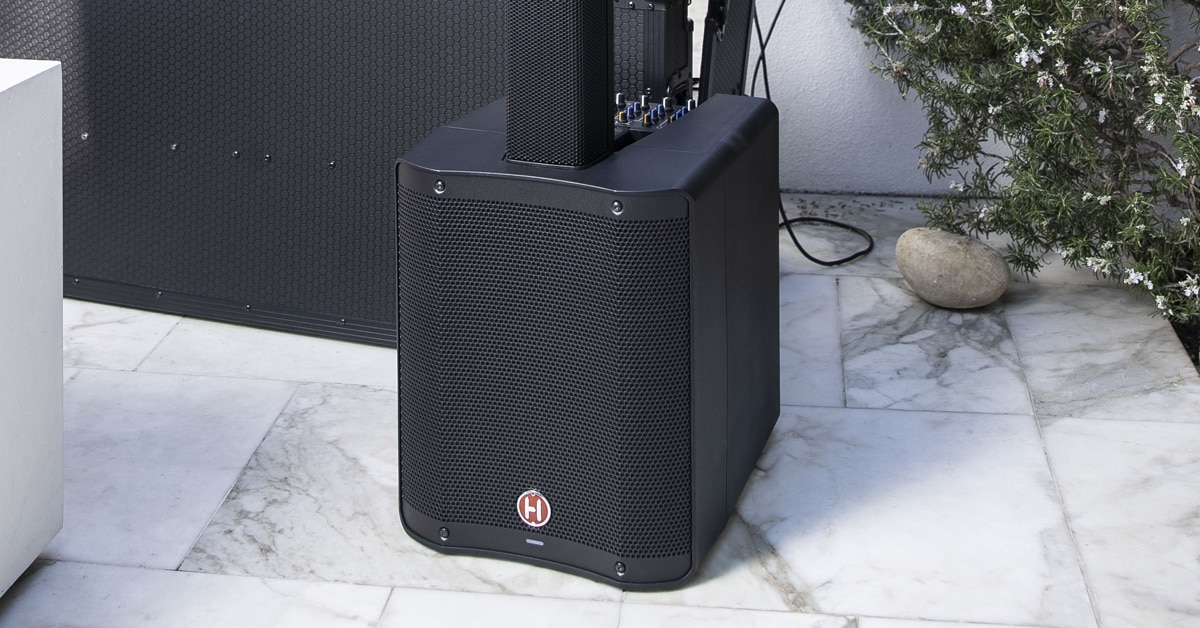As a performing musician, capturing, mixing and amplifying your sound involves choosing a live sound system that’s well matched to your music, budget and the venues in which you play. Whether you're a singer-songwriter performing in a café, a band playing in a local bar or club, or a DJ playing weddings, you're going to need a PA system to be heard. In this guide, we’ll walk you through all the live sound gear you need, tell you how it works and help you find the right PA equipment to make your music sound its best.
Table of Contents
What is a PA System?
Prepackaged PA Systems
Portability vs. Control
PA Power Amplifiers
Live Sound Mixers
Signal Processing (Effects)
Equalizers
PA Speakers
PA Monitor Speakers
Microphones
Cables and Other Live Sound System Essentials
Tips & Tricks
Glossary
As a performing musician, you want a PA system that can deliver your sound with clarity and definition. But with so many different pieces of equipment designed for different live performance needs, it can be difficult to know just what it is you should be looking for.
Certainly, there are a lot of variables to consider when choosing a PA. For instance, you'll need to think about the size of your audience, where your performances will be, how portable you need your system to be and how much money you can invest.
This guide will help walk you through these and other important considerations to help you find the gear that's right for you, whether you're buying your first PA system or looking to add equipment to your existing system.
What is a PA System?
In short, a PA system is a public address system. Also known as a sound reinforcement system, a PA system is an electronic amplification system used to get sound from the performer(s) to the audience. It's made up of several components, and while one system can vary greatly from the next, each one handles these same basic functions:
- Converting acoustic sound into electronic signals, most often with microphones or line inputs
- Processing and mixing these electronic signals, using mixing boards and effects modules
- Amplifying signals with a power amp
- Delivering the sound through speakers
- Monitoring the performance with speakers or in-ear monitors
Different PA equipment will have different capabilities, features and designs associated with each of these functions. Your specific needs will determine what you want out of each.
Prepackaged PA Systems
If you don’t want to get too deeply into the nuts and bolts of PA equipment, you might want to consider one of our complete, live sound PA system packages that include everything you need to get up and running. If you're new to PA gear, these systems can help you avoid the problems that can arise from mismatched PA components. Also, by purchasing bundled gear, you can save a lot of money.
Musician's Friend carries prepackaged systems from great brands like Yamaha, Fender, JBL, Peavey, Mackie and many more—all at the best prices you'll find anywhere—guaranteed.
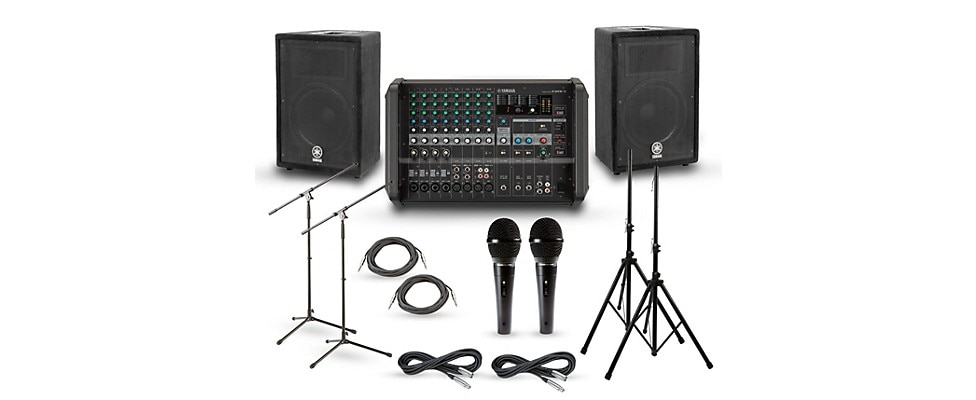
The Yamaha EMX5 with A-Series PA Package 12" Mains offers a complete live sound performance solution. It includes Audio-Technica M4000S handheld mics, cables, floor monitors, the Yamaha EMX5 powered mixer, stands and two Yamaha A-Series speakers.
Musician’s Friend offers hundreds of live sound packages to match a wide range of performance needs and budgets.
All-in-one Modular PA Systems
For solo acts, duos and other smaller groups that play in venues lacking a built-in PA, a modular tower system can be a clean, simple way to get heard with a minimum of fuss. These systems typically house a speaker array, mixer and power amp in a single, column-like structure that breaks down for easy transport. Because the components have been optimized to work with each other and the speaker arrays are designed to generate high-quality, room-filling sound, these systems offer an affordable, portable option to standard PAs.
The JBL EON ONE MKII Linear-Array PA System is an excellent example, delivering robust sound that’s highly intelligible and runs off of lithium-ion battery power. JBL engineers have created an array that serves up pro-quality sound to every corner of the room. A 10” subwoofer adds the kind of bottom end that can sometimes be a weak spot in similar systems. With its Bluetooth-streaming capability, you have the option of going wireless—a great feature for active musicians, instructors and other presenters who roam the stage or room. There are also two USB ports to keep your mobile device plugged in and charged, with no fear of running out of juice. The 5-channel mixer is simple to use and lets you easily connect all your gear while onboard effects make it easy to dial in just the right sound.
The Bose L1 Pro Series offers a variety of options for the professional musician or DJ looking for a super portable, all-in-one system. The three base models are the L1 Pro 8, L1 Pro 16 and L1 Pro 32, so you can find the perfect PA system for your needs. Each L1 Pro system has a built-in mixer, with two combo XLR-1/4” inputs (with phantom power), 1/4" and 1/8″ AUX inputs and Bluetooth connectivity for hooking up your mobile device for streaming audio playback. Use the L1 Mix app for complete wireless control.
The Bose L1 Pro Series is available in a variety of configurations for the musician on the go, offering powerful sound, flexible connectivity and more.
The 1,000-watt Electro-Voice EVOLVE 50 houses a 2-channel mixer, AUX In, plus eight 3.5" neodymium drivers and a 12" woofer. The Harbinger MLS1000 Line Array PA System features a diverse range of input options, including Bluetooth, and it delivers 1,000 watts of powerful sound.
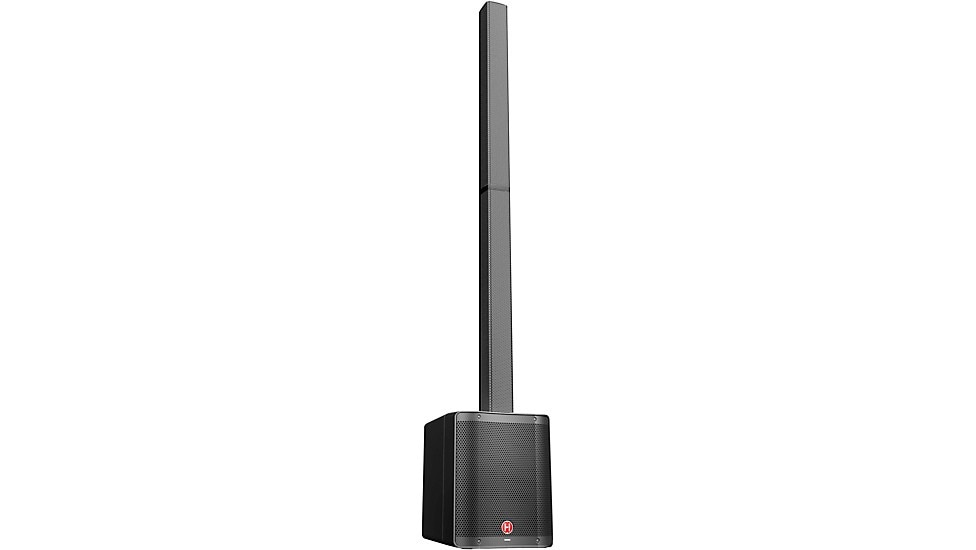
The Harbinger MLS1000 offers four inputs and delivers 1,000 watts of peak output, making it a fantastic choice for the gigging musician.
Mackie's best-selling Thump series was refreshed in August of 2022, with performance-friendly upgrades, including increased total output, intelligent feedback elimination and a handy music ducking feature perfect for DJs who want to address their audience without having to grab a fader.
Portability vs. Control
One important question to start with in your PA system search is “How portable do I need the system to be?”
Traditional PA systems are made up of separate pieces of equipment for each individual function: a standalone mixing board, outboard signal processors, dedicated power amp(s), and a number of individual PA and monitor speaker cabinets. Such systems require considerable space to transport, store and set up on stage.
If you need to transport your PA system frequently to different venues that have modest amplification needs and crowded performance spaces, there are portable, compact PA systems likely to meet those needs. In fact, there are even complete PA systems that include all of the necessary equipment within a single enclosure, roughly the same size as a standard PA speaker.
For small groups or solo performers who play in small venues with basic amplification needs, there are some excellent all-in-one models that deliver plenty of power. The Yamaha STAGEPAS 400i, for example, will handle just about anything you'll need … but in a package that will fit in the trunk of a compact car.
The super compact Bose S1 Pro Multi-Position Powered PA System includes a 3-channel mixer, Bluetooth connectivity, built-in reverb, tone controls and line out.
That said, super compact systems also have their limitations. They do not offer as much control, customizability or sheer sound output as a traditional PA setup. Generally, they can't deliver the kind of high-power performance needed for larger venues, nor do they provide enough inputs for larger groups, especially those with miked drum kits.
If you have more advanced live sound needs but are looking for more portable options, you can find powered mixing boards and powered speakers that have integrated power amps, making a standalone power amp unnecessary. Keep in mind, though, that powered mixers can still have limitations, particularly for bands that plan on expanding their PA equipment in the future. With individual components handling each function in a PA system, it is easier and usually more cost-effective to switch out, upgrade and add individual PA components to enhance the system.
PA Power Amplifiers
One of the most important questions when it comes to PA systems is “How much power do I need?” This is a consideration when purchasing a power amp for the system. The power amp's job is to boost the low-level signals coming from the mixer and broadcast them through the speakers. How much power it produces is measured in watts. And you want to make sure you've got enough wattage to fill the venue without compromising the sound quality.
Exactly how many watts you need hinges on a number of variables. The most obvious of these is the performance location (room size, indoor/outdoor, acoustics). However, there are additional factors that complicate the issue. For instance, there is the efficiency of the speakers (i.e., how much sound the speakers produce per watt of power). There also is the concept of headroom (how much power it takes to handle peaks without distorting) and the desired volume level of the music.
Using speakers with average sensitivity, a rock band playing in a medium-sized club will need around 1,500 watts total power at a minimum, whereas a pop or jazz group might need between 250–750 watts. For simple folk music in the same venue, that requirement can come down to as little as 60 watts. Keep in mind though that these power estimates are generalizations; difficult performance spaces and music with a lot of dynamics can require considerably more power. As we note below, factoring in plenty of headroom will help ensure great sound when you’re performing in a challenging environment.
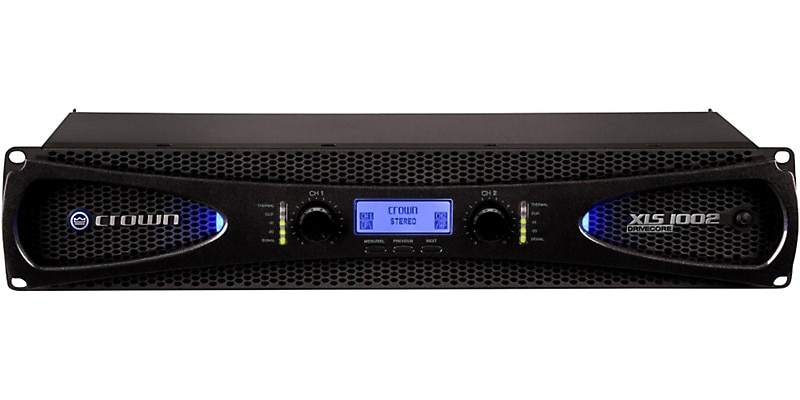
The portable Crown XLS1002 Power Amplifier delivers 350 watts of clean power at 4 ohms and offers extensive user controls, including onboard DSP.
It's important to buy an amp with plenty of power to drive your speakers plus enough headroom to prevent distortion. When shopping for speakers, you'll see that they have a power rating, measured in watts. As a general rule, you will probably want an amp with twice the wattage of your speaker's rated power handling to ensure a clean, undistorted signal gets to them. We will discuss this further when we cover PA speakers and their power requirements.
Keep in mind that a stereo power amp provides two channels, each able to drive its own speaker load. Som if your amp provides 500 watts per channel, a pair of speakers rated for 250 watts would be a good fit. Note that the rated output for stereo power amps is usually given on a per-channel basis. A rating of 2x450W indicates that the amp generates up to 450 watts into each of its stereo channels.
What is Bridged Operation?
Some power amps have a bridged operation mode. Also called mono or bridged mono, in this mode, the load is connected to draw from both channels. That means the amp effectively becomes a higher-powered single-channel monophonic unit, even though both channels are being used.
What's the Deal With Ohms?
One detail on the spec sheet that you want to be sure to check is the ohms rating. Ohms are a unit of measure for the impedance or resistance in a piece of gear.
To understand impedance, imagine a hose plugged up with gunk slowing the water flow. If you want more water to come out, you have to increase the amount of water at the faucet to increase the water pressure.
Well, in regard to electricity, this gunk is the impedance (measured in ohms), and the faucet pressure is the voltage. So, gear with low impedance lets the electricity flow easily while gear with higher impedance requires more voltage to make the electricity flow.
It's important that the impedance rating of your amp matches up to that of your speakers. If it doesn't, there are ways you can work with your gear to make them match. That is, you can change the impedance of your speakers by wiring them in series or parallel. (We will discuss speaker wiring options a little later.) However, your safest bet is to buy power amps and speakers that match, particularly if you are not planning to expand your system.
Most PA power amps are designed to handle speakers rated at 4 or 8 ohms with some that handle 2- and 16-ohm loads also. You’ll note when reading power amplifier specs that the rated power output decreases as the impedance (ohms rating) of the speaker increases. For example, the Crown XLS1002 Power Amplifier illustrated above generates 350 watts per channel when connected to a 4-ohm speaker. Output drops to 215 watts per channel when an 8-ohm speaker is connected.
You'll find the impedance rating for both power amp and speakers in the specifications details on any listing in the Musician's Friend catalog and website.
If you are unsure about the best combination of amplification and speakers for your live sound rig, we invite you to call one of our Gear Advisers for friendly, expert advice.
Shop the huge selection of live sound power amplifiers at Musician’s Friend.
Live Sound Mixers
Electronic signals from microphones and instruments need to be balanced, processed and mixed together before they can be amplified and routed to PA speakers and monitors. In your live music PA, this is where the mixer comes in.
Mixers range in size from simple 4-channel units to much larger consoles that have hundreds of channels. A channel is essentially a signal path. A mixer with a large channel count allows more things to be connected and routed through it.
Channels are usually designed to accept microphones and/or line-level devices, such as amplifiers, preamps or signal processors. (Microphones, and instruments such as guitars and basses, output electronic signals that have a much lower level than line-level devices.)
On a mixer, audio signals are assigned to separate channels, so a fundamental question to start narrowing down your mixer selection is, “How many channels do I need?” Generally, you will want to make sure you have more channels than you think you will require. So, it's important to take an inventory of what you will be amplifying and make sure you have sufficient inputs and outputs while allowing for future expansion of your PA system.
For instance, if you are plugging a standard five-piece rock or pop band into your PA, your first instinct might be to shoot for an eight-channel mixer. After all, that would allow for five instruments with room to spare. However, once you add up the inputs for everything you need for the group, you will find that your eight channels actually won't give you enough inputs.
With a five-piece band, the live sound arrangement might look something like this: one mic for lead vocals and one for backup (two channels), one mic for the guitar amp, one for the bass amp, and at least one direct input for synthesizers (three channels). Then there's the drum kit, which will have its own miking considerations. With two overhead mics for cymbals, a mic on each tom, the snare and the bass drum, you are looking at a minimum of seven mics for a fully miked kit.
This brings your total required inputs to 12 channels, so you’d want a model with a minimum of 16 channels giving you room to expand.
Getting to Know the Mixer
Learning to use an audio mixer might initially seem like a daunting task, with all the buttons, knobs and faders. But keep in mind that every channel has the same controls. Once you learn how to control one channel, you'll know how to control every channel.
Every channel on a mixer is either mono or stereo with an XLR, 1/4” or RCA connection. (Some inputs are designed to handle both XLR plugs from microphones as well as 1/4” inputs.)
A channel strip is a group of circuits and controls that function together on a given mixer channel to affect the audio signals that pass through it. These usually include:
- an input jack where an external instrument, microphone, etc. connects to the mixer. (XLR inputs are balanced to minimize noise and interference. Other inputs accept RCA or quarter-inch TRS connectors while some accept both XLR and 1/4” plugs)
- a microphone preamp that amplifies the relatively weak mic signal, raising it to line-level strength
- equalization, abbreviated as EQ, adjusts the signal’s frequency response in three or more bands
- dynamics processing that may include compression or gating (discussed below)
- routing that directs the signal to other mixer buses and external devices
- a pan control for balancing left and right output
- a fader, which slides along a track to control the input or output level of a channel
- a meter or light display that visually shows the output of each channel
Getting More Control From a Mixer
If you want to be able to make quick adjustments to your mix during a live performance without throwing things out of balance, look for mixers that offer multiple buses.
Basically, once the levels of each channel are set, the signals are combined into either the main mix or into submixes that can be assigned to buses. Buses can be visualized as circuit intersections where the output from several channels meet. Each mixer channel routes its signals to a specific bus or group of buses. These buses allow you to adjust signals as a group before they go into the final mix and out to the speakers. So, for instance, you can easily make adjustments to all the vocals or all the drums using a single group fader control. Also known as auxiliary sends, auxiliary buses can also be used to route mixes to headphones, external effects processors, monitor speakers or in-ear monitors.
You can also make additional enhancements using buses. For example, two-bus mixers normally have a pan control to send a signal to the left or right bus, creating a stereo output. There also may be insert points where you can apply effects to buses before the final mix.
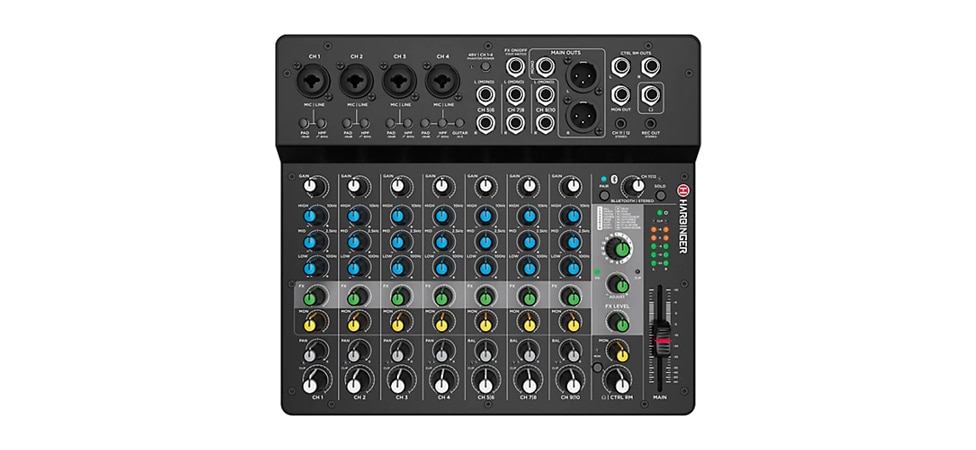
The Harbinger LV12 is a compact 12-channel mixer offering 4 XLR/1/4" combo jacks, 16 onboard diggital effects and Bluetooth connectivity, making it a perfect choice for the studio or the stage.
Digital vs. Analog Mixers
For instant changes to signal routing, flexible and extensive signal dynamics, and an amazing array of effects possibilities, a digital mixer is hard to beat. With the touch of a button, preprogrammed routing and effects can be triggered that would be impossible for even a talented octopus to accomplish on an analog audio mixer.
Some digital mixers are compatible with software plug-ins that extend their tone-shaping capabilities even further. Recently, many digital mixers have added mobile-device compatibility, allowing operation via a laptop, smart phone or tablet.
Digital mixers can also ride herd on dreaded feedback, preventing the howls and squeals before they even start. Another nice feature is automatic gating that silences channels with little or no signal passing through them.
One of the huge advantages of digital mixers is their ability to save and recall mixes. Many use USB flash drives or internal memory to store settings from past performances. This makes the set up in a venue that’s been saved fast and simple. Even in a new venue, recalling mixes from similar venues can be a big-time saver during sound checks. Some digital mixers let you preprogram mixes using a laptop computer, so when you get to the gig, only fine-tuning tweaks to the sound are needed. Some advanced digital mixers have motorized faders that respond to saved configurations.
Despite the greater versatility of their digital brethren, analog mixers remain popular due to their generally lower cost and ease of use. Since their functions are controlled by physical knobs, faders and switches, their operation can be somewhat more intuitive than digital mixing consoles. The downside of their reliance on physical controls is the analog mixer’s generally larger footprint—a disadvantage on cramped stages. Many people find the analog mixer’s signal and hardware routing easier to grasp at a glance since everything is physically present rather than being hidden in the menus of a digital soundboard’s many status screens.
Both analog and digital mixers are capable of transmitting very high-quality sound. The quality and design of their electronic circuits—especially the mic preamps—and in the case of the digital mixer, its analog to digital converter (ADC), have the biggest influence on sound quality. Most sound engineers agree that mics and speakers with their inherently greater degree of coloration and distortion, are the biggest barriers to absolute sound fidelity. That said, well-designed mic preamps that boost the microphone’s output without adding coloration or distortion are critical to good sound. High-quality circuitry and components in the mixer’s gain stages and signal routing will minimize the hiss that inevitably occurs with analog mixers.
Browse the huge selection of analog and digital audio mixers at Musician’s Friend.
Powered or Unpowered?
When you browse the Musician's Friend assortment of audio mixers, you'll notice that we group powered mixers and unpowered mixers separately to simplify shopping. There is only one major difference between these types: Unpowered mixers require one or more separate power amps, while powered mixers have onboard amplification. Powered mixers are often easier to transport, less difficult to set up and often less expensive. But on the downside, they may offer less power than standalone amps, so they are unlikely to work well in larger venues. And as noted before, powered mixers tend to offer less sophisticated control and fine-tuning of sound than non-powered mixers. Additionally, buying powered mixers might be less cost-effective in the long run if you plan to make gradual upgrades to your PA system. That's because you will be replacing both the mixer and the amp when you want to upgrade either component.
Do I Need Another Mixer for Monitoring?
In addition to the main, front-of-house (FOH) mix, you will want your PA system to handle monitoring so the performers can hear themselves. For this, you have a couple of options.
Often, a single mixing board is used to create not only the main mix, but also the individual mixes each performer needs to hear through the monitors. These mixes will need to meet the different requirements of each performer, according to what each player needs to hear.
Monitor mixes are typically delivered using the AUX send connections on the mixing board. To ensure you and other performers are getting a good mix for performing, you'll want to confirm that the mixer has sufficient AUX sends to route individualized monitor speaker mixes to each performer.
Another option for those serious about monitoring is to have a secondary mixing console dedicated to the task. Sure, it's an additional investment, but it can be worth the expense for the quality of sound delivered to the performers.
Learn more about live sound and recording mixing consoles with our expert Mixer Buying Guide.
Signal Processing (Effects)
While many mixers and PA systems now have built-in effects, additional outboard processing gear can help add drama and sparkle to your sound. Although they're not essential in all situations, signal processing and effects, such as compression, limiting, reverb and delay can add sonic interest to your sound that make them well worth the cost.
Here are some basic effects and signal processing tools that can enhance your PA system:
Compression and limiting
A compressor, as the name suggests, compresses the overall dynamics of the audio signal limiting the amount of variation between the loudest and softest sounds. It smooths your sound and protects gear by helping to avoid damage caused by clipping—a speaker-destroying phenomenon resulting from overdriving the amplifier into distortion. Well-designed compressors not only prevent signal distortion, but add pleasing sustain to your sound.
A similar tool, the limiter keeps your speakers and ears from getting blown out by limiting the peaks in the music. A limiter allows compression to occur only above a set threshold, and the compression ratio can be very high. This prevents clipping, distortion and other related problems.
Reverb and Delay
Reverb (from reverberation) is an effect that makes sounds richer, as if they are reflecting off surfaces. Reverb adds depth and dimension—that’s why your voice sounds better when you sing in the shower. The hard, reflecting surfaces add “space” and drama to your vocal performance. The adjustable parameters on a reverb unit allow you to control these reflections to simulate various acoustic environments.
Delay is one or more echoes that have a more distinctly audible space between the initiation of the original sound and its reflection. There is a more distinct repetition of the original sound (partial words, musical phrases, etc.) and an eventual diminishing of volume over time. Delay is the effect you experience when you shout into a large canyon: your voice bounces back to you in diminishing waves.
Other Common Processors
Sonic enhancers such as the BBE Sonic Maximizer give your sound more presence by delaying the low frequencies relative to the higher ones, removing subtle inaccuracies in timing to preserve the sonic characteristics of live instruments.
There are many other processors that offer a huge selection of sound-shaping options to meet all your effects needs. Browse the huge selection of signal processors at Musician’s Friend.
Equalizers
Most mixers include an EQ section. The simplest mixer equalizer controls resemble those found on consumer electronics and typically raise or lower the low, mid-range, and high frequencies. More advanced mixers offer more fine tuning of frequencies as discussed below.
The important role of an equalizer is to balance out your sounds by allowing you to boost or cut highs, lows, and mid-range frequencies to improve your overall sound. The equalizer modifies the signal's frequency response by increasing (boosting) or decreasing (attenuating) selected ranges of frequencies. Equalization can also help fight feedback by letting you pinpoint and reduce the volume of frequencies where it occurs.
The built-in equalization circuits in your mixer may be adequate for fine-tuning your overall sound. But for the most demanding sound applications, a standalone equalizer will likely do a better job.
Types of Equalizers
There are three types of equalizers commonly used with PA systems.
Parametric EQ: Parametric equalizers give you the most flexibility in sound shaping, but are more challenging to use. Unlike graphic EQs that only let you set the amount of boost and cut, parametric EQs allow you to set the gain, center frequency and the bandwidth of a given frequency. The range of the bandwidth is referred to as the Q factor. Parametric equalization controls the relative cut or boost of the signal above and below the center frequency. With practice, parametric equalizers are powerful and flexible tools for helping specific instruments or voices to cut through the overall mix, or to generate a big, full sound.
Semi-parametric/quasi-parametric EQ: These function in the same way as a parametric EQ, however the manufacturer sets the bandwidth—it's not user-adjustable. These units trade off somewhat easier operation with reduced functionality.
Graphic EQ: Graphic equalizers provide more flexibility and control than simple two- or three-band tone controls, and they're quite easy to use. A graphic equalizer is a set of band-pass filters that divide the audio spectrum into 30 or more bands allowing you to control the amount of boost or cut in much narrower frequency ranges. Usually controlled with sliders, the effect of the equalizer is graphically depicted by the positions of the sliders—that's why it's called a “graphic” equalizer. The ease of use offered by graphic equalizers is largely due to the ability to easily visualize how equalization is affecting the overall audio signal by simply looking at the faders.
Graphic EQs are great for sound reinforcement and “tuning” rooms—adjusting the contour of your sound to match the environment. For example, if you’re performing in a space that produces a lot of boominess, you can cut the lower frequencies that are contributing to the problem. Graphic equalizers allow you to produce a consistent sound at every venue.
What Causes Feedback?
That awful noise is the result of a feedback loop. This happens most commonly when your sound travels from the microphone to the mixer to the amp to the monitors, then back into the mic. Instead of just making the signal louder as you might think, the sound frequencies boosted by the loop will be amplified hundreds of times in a fraction of a second, making the squealing, howling noise known as feedback.
The resonant frequencies in a room also can produce feedback. Some rooms tend to overemphasize certain frequencies, and if these happen to be in the range of your vocals or guitar (which is often the case), you’ll have a problem. Certain instruments, such as acoustic guitars, also suffer from the same problem.
Crossovers and Speaker Management Systems
The wide range of frequencies produced in your performance can be better controlled if they’re divided into frequency ranges and sent to the specific speakers designed to handle those frequencies. These speakers (or drivers) can be combined in one speaker cabinet (referred to as full-range speakers) or in separate units. It's the role of a crossover to route these frequencies to the different speakers. Two-way crossovers divide your signal between high and low frequencies; three-way crossovers split the high, mid and low signals, routing each to its designated driver. The high frequencies are sent to the tweeters, the lows are sent to the woofers and the mids are sent to the mid-range drivers.
What's the Difference Between Active and Passive Crossovers?
If the crossover is built into your full-range speaker cabinet, it's a passive crossover (in some models, it can be bypassed if you decide to use an active crossover). The crossover is activated when the signal passes through it using inductors and capacitors to divide and send the signal to the appropriate speaker drivers. An inductor responds to low frequencies and sends them to a woofer, while a capacitor picks up high frequencies and sends them to the tweeter. A mid-range crossover uses a capacitor and an inductor (called a band-pass filter) to set upper and lower cutoff points to send this signal to the mid-range driver.
Active crossovers are placed before the power amps and split the signal to send each frequency range to its own amp. It is easier to adjust the frequency ranges sent to each driver with an active crossover. If the active crossover splits the signal between two amps, this is called bi-amping (two-way); if it's split three ways, it's called tri-amping (three-way).
What are the Benefits of a Speaker Management System?
Speaker management systems such as the dbx DriveRack PA2 are designed to be everything you need between your mixer and speakers. Features like auto EQ, a pink noise generator, crossover, limiting, compression, etc., can make sound checks, feedback control and level setting much easier. These systems, typically used by pros and in large touring systems, are becoming more and more common for entry-level users for overall dynamic control.
PA Speakers
Once your mixer, signal processing gear and power amp have shaped your audio signals, it's your speakers' job to turn those signals back into physical sound waves. Speakers reinterpret the signal by using the voltage from the amplifier to move their cones back and forth, producing the sound waves that reach the audience’s ears.
Maybe it goes without saying, but speakers play a critical role in delivering quality sound to an audience, and it’s an area where quality gear can make a real difference.
As is true for the power amp, the size of the venue you play will help you decide on the power handling (wattage) and size of the speakers needed. For example, smaller gigs, conferences and lectures may require about 350–500 watts, while club bands, garage bands, and mobile DJs may need 500–1,000 watts, or even more, depending on the venues they perform in.
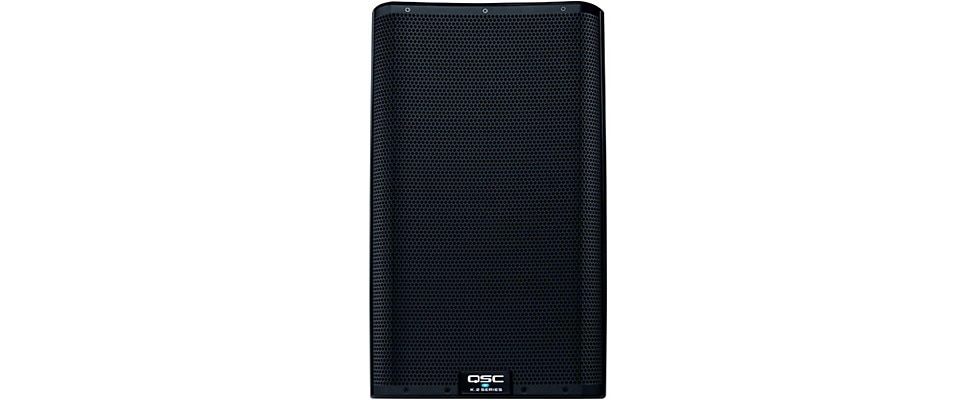
The QSC K12.2, a top-selling powered speaker, is a two-way design with a powerful Class-D amplifier that pumps up to 2,000W of peak output through a 12" woofer and a 1.4" high-frequency compression driver. It also features 11 different DSP factory presets to customize the speaker's sound.
In choosing PA speakers, the key trade-offs to consider are portability versus performance. While full-range speaker cabinets that contain a woofer, mid-range driver and tweeter are more portable and easier to set up, they typically won’t deliver the same performance as high-end speaker arrays.
What Type of Individual Speakers are There?
Speakers are designed to reproduce specific frequency ranges. So-called “full-range” speaker cabinets usually contain a woofer and tweeter, and are referred to as a two-way system. Some PA speaker cabinets also include a mid-range driver and are referred to as three-way systems.
Here are the individual type of speakers and their characteristics found in PA systems:
- Woofer: Reproduces low frequencies, usually with a 10”–18” cone-type driver
- Frequency range: Usually below 500Hz
- Mid-range: Reproduces mid frequencies, sometimes with a 5” to 12” cone-type driver, sometimes a 2-1/2” to 4” compression driver mounted on a dispersion horn
- Frequency range: Generally between 200Hz and 3kHz
- Tweeter: Reproduces highest frequencies with a 1” to 2” cone-type driver or a 1” to 4” compression driver
- Frequency range: Usually between 2kHz and 20kHz
- Subwoofers: Reproduce the lowest frequencies with 15” to 24” cone-type driver
- Frequency range: Rarely above 300Hz down to 30Hz or lower
Should I get Powered (Active) or Non-Powered (Passive) Speakers?
For those who want to avoid purchasing one or more dedicated power amps for their PA systems, powered speakers are a popular option that integrate amplifiers directly into their cabinets. Using powered PA speakers means you can also use a non-powered mixer. Powered speakers are a great option for musicians who play at smaller clubs and other venues. They offer greater portability and reduced set-up hassles.
The QSC CP Powered Speakers are available in two models: the QSC CP8 and the QSC CP12. They're lightweight and easy to transport, sound great and offer plenty of punch.
The trade-off is that powered speakers provide less flexibility and control over a PA system than separating the power amp from the speakers. Typically, the largest speaker systems designed for bigger performance spaces are non-powered. For this reason, many professional live sound engineers prefer passive speakers that can be configured and positioned to optimize their sound in specific venues.
To make shopping for PA speakers easier, the Musician’s Friend website offers separate assortments of passive versus powered models.
Should I Add a Subwoofer?
Subwoofers are the large speakers that handle the lowest bass frequencies. They are not integrated with full-range enclosures both due to their size and the potential damage that can be caused to other components by their strong vibrations.
Adding a subwoofer will of course make your PA less portable overall. Unless you opt for a powered subwoofer, you will also need a power amp capable of supplying the wattage required by power-hungry subs. Bands that play heavy rock, metal, reggae, hip-hop and other styles that depend on powerful bass and drum sounds are most likely to want to include a subwoofer.
As with other PA speaker cabinets, you’ll find a large assortment of passive unpowered and active powered subwoofers available at Musician’s Friend.
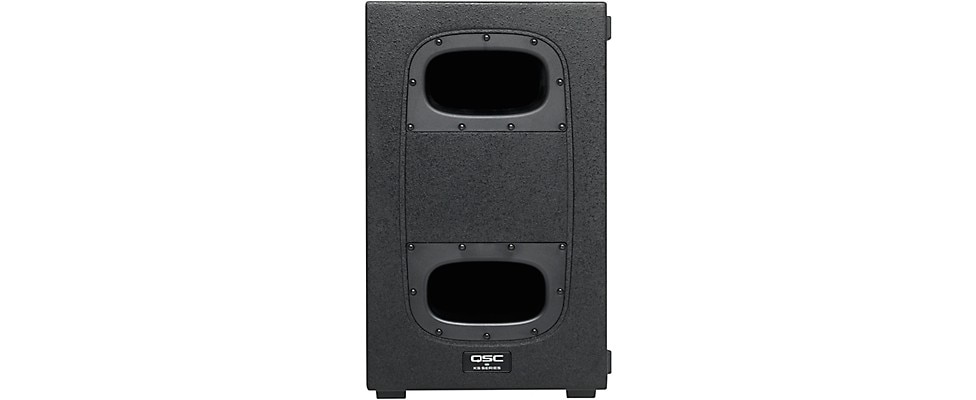
The QSC KS112 12" Compact Powered Subwoofer, which offers 2,000-watts peak/1,000-watts continuous output, reproduces frequencies down to 41Hz and up to 108Hz, bringing out the full chest-pounding bottom notes of bass guitars and kick drums.
PA Monitor Speakers
Musicians need to be able to hear themselves and other performers clearly to sound their best, which is why stage monitors are essential. While floor monitors can cause feedback and increase the risk of hearing damage, they are preferred over in-ear monitors by many performers because they are easier to use. These usually wedge-shaped speakers allow performers to hear themselves and play better because of it.
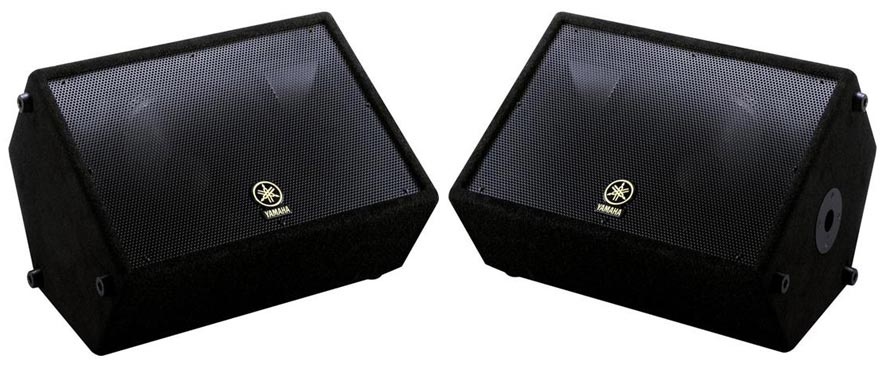
The popular Yamaha A12M Floor Monitor has a 12” woofer, 1” high-frequency horn and handles 300 watts of continuous power.
In-Ear Monitoring Option
Wireless in-ear monitors allow performers to move more freely around the stage and to hear an individualized mix. They eliminate monitor feedback worries, potential hearing damage and the stage clutter of floor monitors.
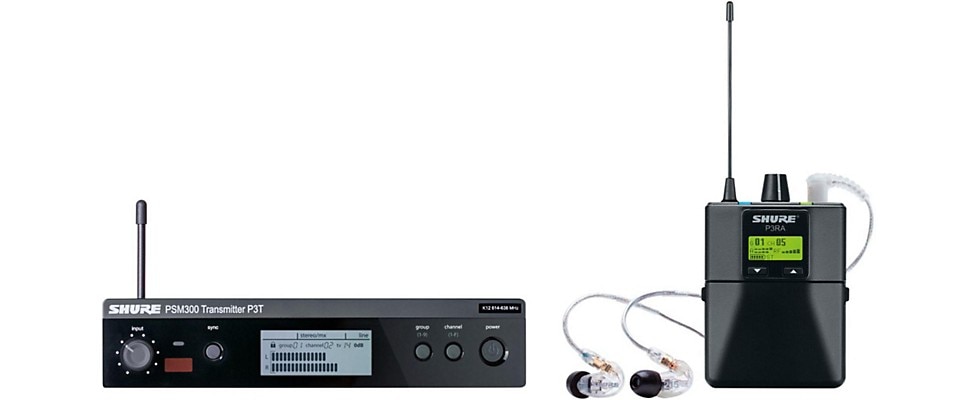
The Shure PSM 300 Wireless Personal Monitoring System includes a transmitter, receiver and earphones for a complete monitoring solution that delivers excellent sound quality.
How Wiring Speakers in Parallel or in Series Affects PA Requirements
When you're pairing your power amp or powered mixer with your speakers, you know you need to match the ohms rating on the equipment. However, depending on whether you wire multiple speakers in series or in parallel effects those requirements. So, before you buy your gear, you'll want to be aware of how this works.
Wiring a speaker system in parallel will decrease the amount of ohms (and thus resistance). A typical two-way PA speaker is rated at 8 ohms. If you wire two speakers in parallel, the impedance will be 4 ohms; three will be about 2.67 ohms; and four will be 2 ohms. Although a smaller impedance rating means the electricity flows more easily, some amps can't handle a 2-ohm load, so be sure to consult your manual before connecting your speakers.
Wiring a system in series, on the other hand, will increase the impedance by adding the ohms together to create more resistance. So, if you wire two 8-ohm speakers in series, the load will be 16 ohms. If you have some identical speakers with lower impedance than the amp can handle, a series circuit can come in handy to raise the impedance.
Microphones
Almost every PA system will need mics. With so many types to choose from, you may want to consult the Musician's Friend Microphone Buying Guide to get familiar with the basics.
There are two major microphone types: dynamic and condenser. Dynamic mics are durable, reliable and made for onstage use. For vocals, you will likely want one similar to the legendary Shure SM58.
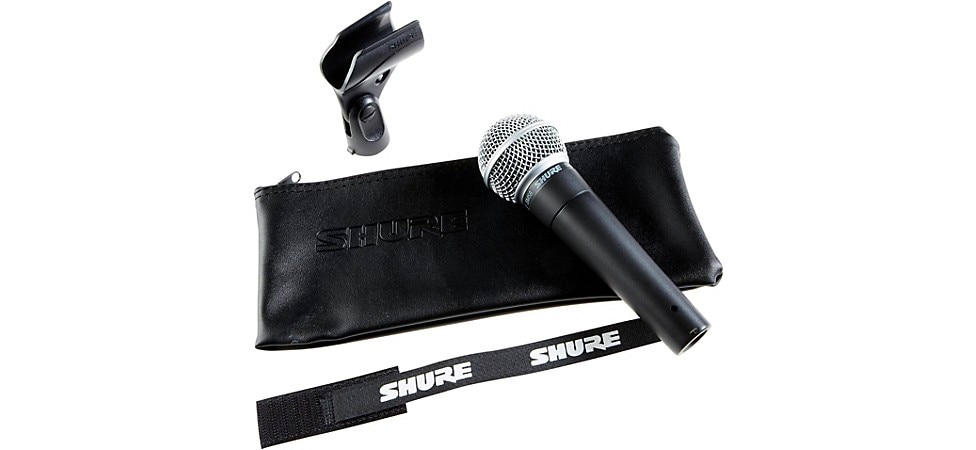
The Shure SM58 is among the most popular onstage dynamic mics thanks to its bulletproof construction, excellent audio performance and its versatility in capturing everything from vocals to guitar cabinets.
Condenser mics are made to capture more subtleties, handle high sound pressure levels (SPLs) and capture fast transients. They are usually used for recording, but can also be perfect for live sound. They’re often positioned above drum kits to capture the sound of cymbals. Condenser mics require phantom power, so you will need to ensure that your mixer includes sufficient phantom-powered inputs.
To minimize feedback, you also will want a mic that is unidirectional (as opposed to omnidirectional) for vocals and instruments. Unidirectional mics are available with cardioid, supercardioid and hypercardioid pickup patterns. Cardioid mics are ideal for live sound situations because of their wide, forgiving pattern.
If you decide to use condenser mics in your system, they usually require phantom power, which means the power needed to run the mic must be delivered from another source, usually the mixer or a mic preamp, through the mic cable or from a separate standalone phantom power device. If you buy a phantom-powered mic, make sure you have a power source available.
Wired or Wireless Microphones?
Ask yourself how much you'll be moving around on stage. Will there be audience participation? Will you be moving off the stage? If so, you probably need a wireless mic setup.
If not, wired mics are more affordable and are more likely to come with PA system packages. Also, you can plug in as many as your mixer can handle without the risk of interference sometimes present with wireless systems. Using wireless mics and in-ear monitoring systems also adds complexity to your gig setup process.
Cables and Other Live Sound System Essentials
Cables carry the audio signals through your sound system. They should be carefully selected to ensure your sound remains clean from the source to the speaker.
In most cases, you'll need balanced XLR microphone cables and/or TRS (stereo) 1/4” cables for live sound, as well as unbalanced 1/4” connectors that are typically used for instrument cables. Balanced cables eliminate the noise from lights and other electronic sources often referred to 60-cycle hum.
speakON connectors have rapidly replaced 1/4” connectors in many systems due to their ability to lock the jack to the plug, preventing accidental disconnection.
For speaker cables, the larger the conductor size, the better the ability to carry the much higher current required to drive speakers. Also, the thicker the jacket, the better it'll hold up. Place the power amp as close as possible to the speakers and use the shortest cable possible to maximize efficiency.
Instrument cables and speaker cables are not interchangeable. Speaker cables are not only thicker, they are constructed differently, so substitutions can lead to damaged gear.
Browse the huge selection of instrument, microphone and 1/4” cables, plus cable snakes and cable adapters at Musician’s Friend.
You'll most likely also want to get a snake, which is a multichannel audio distribution system that allows you to run a large number of inputs from, for example, the stage to the mixer without using many individual cables.
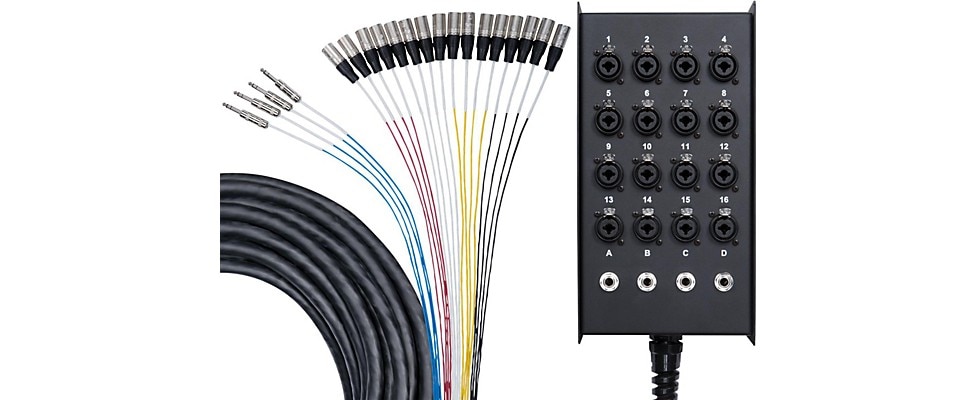
The Livewire Advantage 16x4 Snake has 16 female XLR/TRS inputs with matching inputs on the rugged stage box. Four 1/4" TRS return channels handle monitor mixes or headphone cues. Four TRS male connectors send the master output to your mixing console.
Other PA essentials
We highly recommend getting a cable tester. If your system isn't working correctly, a cable tester can save you hours of troubleshooting. We also recommend that once you find the defective cable, you immediately throw it away rather than putting it in a box to be accidentally used again someday, only to find that it (still) doesn't work.
You may also want a dB meter; many venues require that you don't exceed a certain volume level, and a dB meter will let you accurately monitor your volume.
Browse the complete selection of cable testers and dB meters at Musician’s Friend.
If your PA system is not being installed, you'll need some heavy-duty cases or bags to transport your gear. Well-built, durable cases are essential to protect your valuable equipment.
Speaker stands and brackets are another must-have accessory. Make sure to get sturdy, reliable nonskid stands that are strong enough to hold your gear securely. Check out the individual adjustability of each stand and make sure it will get your gear into an optimal position. Read specs to ensure the stands are rated to handle the weight of your speaker cabinets.
Microphone stands are also an essential accessory for most PA rigs. You’ll find a broad range of mic stands designed to position mics for vocalists, instruments and speaker cabinets. Choose designs with stable bases/tripods that will resist being easily knocked over during performance. Mic stands with adjustable booms allow more flexible placement.
If you want to learn more about how to run a PA system, we have many great reference books to further your live sound system knowledge.
Tips & Tricks
Here are a handful of tips and tricks that will help you get the most out of your PA system:
- When pairing speakers on each side of the stage, place them in an arc configuration to widen sound dispersion, allowing the speakers to act like a single cabinet with a greater coverage area.
- Never use your elbow to coil cables as it will ultimately damage them. Gather them in a figure-8 shape instead.
- Use cables with the right gauge wire. Find the minimum recommended conductor gauges below:
|
Load |
Less Than 100' |
More Than 100' |
|
16 ohms |
16 gauge |
14 gauge |
|
8 ohms |
14 gauge |
12 gauge |
|
4 ohms |
12 gauge |
10 gauge |
- Don't forget that the power amp is the last thing you turn on when powering up and the first thing you turn off when powering down your PA system. This prevents potential damage to connected equipment and subjecting your audience to noise.
What Terms Should I Know When Buying PA Equipment?
It’s important to know what you’re talking about before you buy! Here are the core terms you should know when looking at any PA system.
- Continuous program power handling: The level of long-term average power the speaker will handle. This spec is sometimes given (somewhat incorrectly) as RMS power (see RMS below).
- Dynamic range: The difference between the loudest and softest parts in an audio signal (usually measured in dB).
- Frequency response: Refers to the range of frequencies gear will accurately reproduce from input to output. The range of human hearing is 20Hz–20kHz. When reading frequency responses, the spec may refer to the tolerance—the maximum level the output will differ from the input. If not specified, the tolerance is probably a standard ±3dB.
- Peak power handling: The maximum instantaneous, short-term power the loudspeaker can handle. This is a less critical spec than continuous program power handling, and sometimes is used to create a more positive impression of speaker systems.
- RMS (root mean square): The square root of the average (mean) of the squared values of all the instantaneous voltages on a waveform. RMS ratings of speaker power handling are fairly conservative. Continuous program power handling is sometimes—though technically incorrectly—called RMS.
To learn more, read our Tech Tip about understanding audio gear specifications.
Glossary
1/4" Jack: also known as phone plug , an unbalanced connection using a phone-patching cord connector, the most basic connection in audio
Amplitude: the strength of an audio signal, measured in dB, at a given point in time
Attenuation: the loss or reduction of amplitude of a signal
Auxiliary Bus or AUX Bus: a bus dedicated to transmitting audio signals separately from the main bus. (See also Bus)
Balanced: an audio circuit with two shielded conductors with reverse polarity and equal at ground. Balanced wiring provides noise-free transfer of audio in areas susceptible to noise, like recording studios and live sound venues and requires balanced I/O and balanced cables
Band: portion of the frequency spectrum
Bi-amplification or Bi-amped: the practice of using separate power amplifiers to drive a woofer and a tweeter in a loudspeaker; often combined with active amplification, where the amplifier is built into the speaker cabinet
Board: slang for mixing console
Bus: an electrical circuit that transmits audio signals from one or more sources to one or more other sources; the path an audio signal travels in a mixer
Cardioid: heart-shaped microphone polar response pattern ideal for live sound
Channel: a single path of audio through a mixer, processor array, recording channel or computer interface
Clipping: when the peaks of the signal's sound wave are cut off due to the inability of an electronic device to accommodate the current or voltage, causing distortion
Compression: a reduction in gain or dynamic range of a signal by a compressor that can be used to even out an erratic signal, fatten up sounds, extend sustain of a guitar, sweeten vocals or push certain sounds forward in the mix of a song by increasing the overall level
Compressor: a unit that applies compression to an audio signal, usually with controls for sculpting exactly when and how much compression is applied to the signal
Continuous program power handling: the level of long-term average power the speaker will handle. A worst-case spec that represents maximum heating that the speaker's voice coils can withstand
dB/Decibel: a logarithm that describes the ratio of two powers (1/10th of a Bel); some approximate reference points: a normal conversation has a decibel level of 60dB, a ringing telephone is 80dB, shouting in the ear is 110dB and a jet engine during takeoff is 150dB
Delay: one or more distinct echoes that have a more distinctly audible space between the initiation of the original sound and its reflection, and an eventual diminishing of volume over time
Dynamic range: the difference between the loudest and softest parts in a song (usually measured in dB). (See also SPL or Sound Pressure Level)
Enhancer: also called an exciter. A signal processor that uses frequency analysis, compression, EQ and filters to add sparkle to audio; used frequently to bring certain aspects of a song forward in the mix
EQ: short for equalization; usually refers to an equalizer circuit that provides control over the frequency response of an audio signal that passes through it; can be used to shape sounds to be more desirable or cut out undesirable sounds within an audio signal
Exciter: also called an enhancer; a signal processor that uses frequency analysis, compression, EQ, and filters to add sparkle to audio. Used frequently to bring certain aspects of a song forward in the mix, especially during mastering
Fader: a sliding lever that typically adjusts levels. Has the same function as knob-based controls but provides a smoother response, more fine-tuned control and visual feedback for quickly determining level
Filter: an audio circuit that reduces the level of frequencies outside a preset range
Frequency: the rate of variation of a wave or signal
Frequency range: the set of frequencies a piece of audio gear is capable of handling with accuracy. Uses a specification such as 20Hz–20kHz
Frequency response: refers to the range of frequencies gear will accurately reproduce from input to output. The average person can hear frequencies from about 20Hz–20kHz. When reading frequency responses, the spec may refer to the tolerance—the maximum level the output will differ from the input. If not specified, the tolerance is probably a standard ±3dB. The spec (20Hz–20kHz ±3 dB) means that for a given input signal, the listed range of frequencies (20Hz–20kHz) will produce output within the specified range of levels (±3dB); as an example, the frequency response of a Shure SM57 microphone is a vocal-tailored from 50Hz to 15kHz
Gain: amplification
Gain-before-feedback: the total amount of volume possible before feedback occurs
Headroom: the difference between the highest signal possible without distortion and the average signal level through a system
Hertz (Hz): frequency in cycles per second
Hi-Z: short for high impedance. Z is a popular abbreviation for impedance; Hi is simply a shortened version of high; usually refers to a 1/4" line input with high impedance, typically several thousand ohms or more, and often provided as an input on a mixer, multitrack or computer audio interface for a guitar or bass
Hypercardioid: even narrower polar pattern mic than supercardioid for the greatest side-to-side rejection of stray, unwanted sound sources
I/O: short for inputs/outputs
Impedance: the resistance of a circuit to the flow of alternating current, measured in ohms; in audio, impedance is typically classified as low or high and often referred to as Lo-Z or Hi-Z
Inverse square law: the mathematical relationship of the signal strength and distance, where signal strength is inversely proportional to the square of the distance
Level: the amplitude/strength of a signal
Limiter: a signal processor that controls the dynamics of an audio signal; works similarly to a compressor and often used in the same way, but a limiter establishes an absolute output level threshold and prevents any signal that enters from breaking that threshold
Mixing: the process of using a mixer, either hardware or software, to adjust levels and EQ of an audio performance or recorded audio in an effort to pleasingly enhance and balance the audio
Noise: undesirable or unwanted sound which is introduced to an audio signal by other electronic equipment or excessive gain; includes hum, hiss and interference
Ohm: one ohm is the measure of electrical resistance in a circuit when one amp of current is flowing with one volt being applied to the circuit
Omnidirectional: microphone polar pattern that picks up sound from every direction
Peak power handling: the maximum instantaneous, short-term power the loudspeaker can handle
Phantom power: DC voltage usually between 12 and 48 volts applied to an XLR mic input to power condenser microphones; often mixers, preamps and audio interfaces have phantom power built in; outboard phantom power supplies are also available
Phone plug: also known as 1/4" jack; an unbalanced connection using a phone-patching cord connector; the most basic connection in audio
Pink noise generator: makes a sound like a rushing waterfall, meant to reproduce all the sounds that will go through your system during a show by exciting all the audio frequencies with equal energy per octave; used to test a PA before the show, some mixers have a built-in pink noise generator
Polar response pattern: graphical representations of a mic's pickup pattern
Power amp: a device that increases the power of an audio signal by matching the input to the output of a regulated power supply; in live sound, power amps are used to amplify the processed and mixed signal providing power the speakers
Power conditioner: an electronic device that sits between a wall outlet and electronic equipment, which provides protection against spikes and surges in power; typically conditioners also provide some type of noise filtering against electronic signal interference
RCA connector: more correctly called a phono plug, this connection was developed and popularized by the RCA corporation in use with their audio equipment, resulting in it being called RCA. Most often used in stereo pairs and more common in consumer audio gear
Reverb: a series of multiple sound reflections that extend the impact of the original sound; in nature, this is caused by a sound that originates within a space enclosed by hard surfaces; also refers to the electronic equipment developed to replicate this acoustic phenomenon
RMS or root mean square: the square root of the average (mean) of the squared values of all the instantaneous voltages on a waveform; continuous power handling is sometimes—though technically incorrect—called RMS
Signal-to-noise ratio: the ratio of the desired signal's volume to the unwanted noise, usually measured in dB; manufacturers measure this ratio in many different ways, but basically the higher the number, the better and cleaner the signal
Signal processor: generic term which loosely describes components such as compressors, limiters, EQ, microphone preamps, noise gates, reverbs, chorus, delays, modulation, filters and enhancers/exciters; all are used in audio to process sound in order to achieve a desirable effect
Slew rate: the amplifier's ability to react to quick changes in signal voltage; for amps rated up to 100W continuous, the slew rate should be at least 10V per microseconds; for amps over 200W continuous, it should be at least 30V per microsecond
Sound Pressure Level (SPL): the level of acoustic sound waves, measured in dB; a typical SPL reading for a rock concert is 95dB
Stereo: two channels of audio, usually designed as left and right
Supercardioid: narrower microphone polar pattern for better sound isolation
Transients: the sporadic higher levels in your program (from a percussion or guitar attack, for example) that can result in overload distortion if not properly compressed
TRS: stands for Tip, Ring, Sleeve; TRS is a balanced circuit that uses a phone plug-style connection with three conductors (the tip, the ring and the sleeve) instead of just two (the tip and the sleeve)
Unbalanced: an audio circuit whose two conductors are unequal at ground, usually because one conductor operates as ground; an unbalanced audio circuit is more susceptible to noise problems than balanced circuits; noise can be combated by keeping lines as short as possible
Unidirectional microphone: mics that are most sensitive to sources directly in front of them, minimizing off-axis sound and background noise
XLR: balanced, circular 3-pin connector typically used for microphone and line-level signals; each pin is a separate channel, but pin 1 is always ground; the connection was developed by Cannon and is sometimes called a Cannon connector.





































































































































